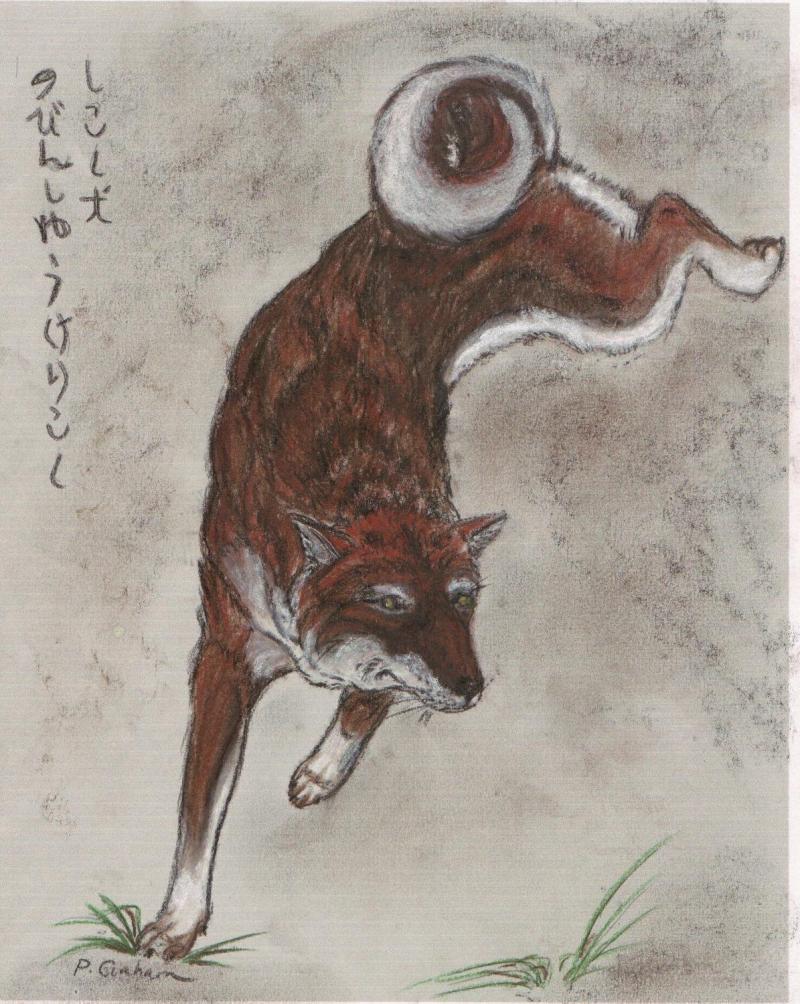HISTORY
The Shikoku Dog: A Most Rare and Primitive Breed
by Margaret Graham
The original Shikoku, or Kochi-ken, (ken= dog) existed in the mountain ranges of Kochi Prefecture on the Island of Shikoku. This remote area is defined by mountainous terrain that is not easily accessible by outsiders. Therefore during the development of the Shikoku as a hunting dog, it maintained a high degree of purity. Furthermore, those who preserved the Shikoku were isolated from each other limiting the ability to crossbreed lines. This isolation contributed to the breed developing into different strains.
The original bloodlines of the Shikoku dog have been traced to five distinct strains that were identified by their unique physical features. It is documented that there were two original Shikoku lines: The Eastern Shikoku and the Western Shikoku. The Eastern, or Mount Tsurugi Shikoku dog, existed at the northwestern foot of the mountain as the Tokushima (Iya) strain and at the southeast foot of the mountain as the Kochi-Aki strain. The Western, or Mount Ishizuchi Shikoku dog was known by three strains: Hata Uwahara from the southwest, Honkawa from the south, and Ehime-ken Shuso-gun from the north. As there is no information available that describes the physical differences between these strains, one can only hypothesize based upon general environmental factors and breeding preferences of the region. Maybe the dogs from the north, or high elevations, had thicker coats, or certain lines carried particular coat colors, or some lines were taller and leaner to allow it to maneuver through the thicket. All these factors can be considered in the development of the Shikoku dog.
The Shikoku dog of the past was highly valued by the Matagi (Japanese hunters) as dog used to track mainly wild boar. The dogs were trained by two methods to hunt. "Hoeru-dome=barking to detain" and "Kami-dome=biting to detain." Most hunters bred their dogs for "Hoeru-dome" way of hunting to keep their dogs at a safe distance from an angry boar and risk of injury.
It was not until the later introduction of western dogs into their culture that the Japanese began to recognize the value in documenting and preserving their native Japanese dog breeds. It was during the Showa Era (1926-1988) that the Japanese Dog Protective League was established. Native dogs, to include the Shikoku, were collected from remote areas of their origins and brought down to the cities and placed in kennels to be protected. During this selection, it is not known exactly which strains of Shikoku dog was taken or if strains were blended in the cities.
The modern day Shikoku dog has received the most influence from the Western Shikoku bloodlines, Honkawa and Hata.
The Honkawa line is characterized by its slender build, stamina, and agile movement. Generally this line has a lighter bone structure and lacks an undercoat. Japanese breeders note that this line carries excellent shape of ears and dark colored eyes. During the era before the second World War, more than 80% of Honkawa Shikoku were black sesame (black and tan). Most influential dogs: Choshun, Kusu, and Kuma. Among them, Choshun is the most important. Almost of all Shikokus of today have his blood. Choshun-go [ BOB at the Nippo National Show, 1938]. Kusu-go [BOB at the Nippo National Show, 1936].
By comparison, the Hata line is characterized by its heavier bone structure. The front body is more developed than the rear. This line possesses a wider skull, smaller ears, and a rich undercoat. There is also a difference in the shape and color of the eyes. The Hata Shikoku is mostly sesame and red. Black & tan is rare. Most influential dog: Goma-go [BOB at the Nippo National Show, 1937].
After the war, the Shikoku dog was bred and known by two bloodlines. The Choshun line (Honkawa line) and Matsukaze line (Hata line). The Choshun Shikoku were descendants of Choshun-go. The Matsukaze Shikoku was descendants of Matsukaze-go (descendent of Goma-go. BOB at the Nippo show, 1950). These two lines, Choshun and Matsukaze, were bred separately after the war until about 1955. It was following this time that the lines were mixed to improve the breed. Presently, there is no separation between the Honkawa line and Hata line, although characteristics of each can be seen represented in the breed.
The Shikoku, as it is known today, is a medium-sized dog ranging in weight between 30-50 lbs. The accepted coat color for the Shikoku is sesame, red sesame, and black sesame. The standard markings are called "urajiro" which can be interpreted as white or lighter color defining the ventral area of the dog [the sides of the muzzle, the cheeks, below the jaw and neck, on the chest and abdominal area, the underside of the tail, and on the inside of the legs] and areas defining the brow of the eye. Crème or white Shikoku ken and markings other than urajiro may occur and can be argued as not acceptable for show.
Although this breed resembles a large Shiba-Inu, there are differences between the two breeds. The Shikoku dog’s general temperament exhibits more of a calm nature with less willfulness or stubborness. They have a tolerant disposition and are naturally obedient and submissive to their owner. The Shikoku dog's primitive nature requires an experienced dog owner. This breed is reserved and aloof, especially around strangers. It is best to give this breed proper socialization from an early age. Shikoku dogs possess a high prey drive and are very quick to react to this instinct.
The Shikoku dog is extremely rare and only a small number are known to exist outside of Japan. Great efforts are being made to protect and preserve this breed. The Shikoku dog is truly a natural treasure.
Copyright 2010 shikoku dog. All rights reserved.
